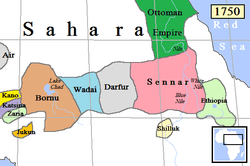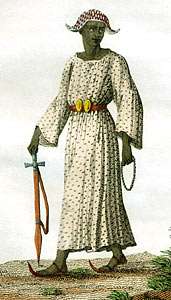سلطنت زرقا
سلطنت زرقا (The Blue Sultanate) (عربی: السلطنة الزرقاء) جسے سلطنت سنار (Sultanate of Sennar) یا سلطنت فنج (Funj Sultanate) بھی کیا جاتا ہے سوڈان کے شمال میں ایک سلطنت تھی۔ فنج نام وہاں کے نسلی گروہ کے نام پر ہے۔
| سلطنت زرقا The Blue Sultanate Funj Sultanate | ||||
| السلطنة الزرقاء (عربی) | ||||
| متحدہ ریاست[1] | ||||
| ||||
 Location of Sennar | ||||
| دار الحکومت | سنار | |||
| زبانیں | عربی[2] | |||
| مذہب | اسلام[3] | |||
| حکومت | بادشاہت | |||
| 'مک' (سلطان) | ||||
| - 1504–1533/4 | امارہ دنقس (اول) | |||
| - 1805–1821 | بادی ہفتم (آخر) | |||
| مقننہ | عظیم کونسل[4] | |||
| تاریخی دور | ابتدائی جدید دور | |||
| - قیام | 1504 | |||
| - محمد علی پاشا نے فتح کیا | 14 جون 1821 | |||
| - مصر میں شامل | 13 فروری 1841 | |||
| آبادی | ||||
| - 1820 تخمینہ | 5,156,000 | |||
| سکہ | کوئی نہیں (مقایضہ) | |||
| Warning: Value specified for "continent" does not comply | ||||

سلطنت سنار کا ایک سلطان
حوالہ جات
- Ofcansky, Thomas۔ "The Funj"۔ Sudan: مطالعہ ملک (Helen Chapin Metz، اشاعت۔)۔ کتب خانہ کانگریس فیڈرل ریسرچ ڈویژن (Research completed June 1991)۔
- Neil McHugh۔ Holymen of the Blue Nile: The Making of an Arab-Islamic Community in the Nilotic Sudan, 1500–1850۔ Series in Islam and Society in Africa۔ Evanston, IL: Northwestern University Press۔ صفحہ 9۔ آئی ایس بی این 978-0-8101-1069-4۔ مورخہ 25 دسمبر 2018 کو اصل سے آرکائیو شدہ۔
The spread of Arabic flowed not only from the dispersion of Arabs but from the unification of the Nile by a government, the Funj sultanate, that utilized Arabic as an official means of communication, and from the use of Arabic as a trade language.
- J. Spencer Trimingham۔ "Islam in Sub-Saharan Africa, till the 19th century"۔ The Last Great Muslim Empires۔ History of the Muslim World, 3 (اشاعت 2nd۔)۔ Princeton, NJ: Markus Wiener Publishers۔ صفحہ 167۔ آئی ایس بی این 978-1-55876-112-4۔ مورخہ 25 دسمبر 2018 کو اصل سے آرکائیو شدہ۔
The date when the Funj rulers adopted اسلام is not known, but must have been fairly soon after the foundation of Sennār, because they then entered into relations with Muslim groups over a wide area.
- Galbraith Welch۔ North African Prelude: The First Seven Thousand Years۔ New York: W. Morrow۔ صفحہ 463۔ او سی ایل سی 413248۔ مورخہ 25 دسمبر 2018 کو اصل (snippet view) سے آرکائیو شدہ۔ اخذ شدہ بتاریخ 12 اگست 2010۔
The government was semirepublican; when a king died the great council picked a successor from among the royal children. Then—presumably to keep the peace—they killed all the rest.
This article is issued from
Wikipedia.
The text is licensed under Creative
Commons - Attribution - Sharealike.
Additional terms may apply for the media files.